

Cornwell Display
|
The Cornwell Display, which consists of the rededicated John Travers Cornwell, VC print, replicas of Jack Cornwell’s medals and an Alumni Challenge Coin, appeared at the Winnipeg Millennium Library ground floor display case during the month of June 2016. After it was displayed there, it moved to the Manitoba Naval Museum quarterdeck display case at HMCS Chippawa. The display was created, and showings arranged by, John Jamieson, Rick Hunt and Pam Shaw.
|
|
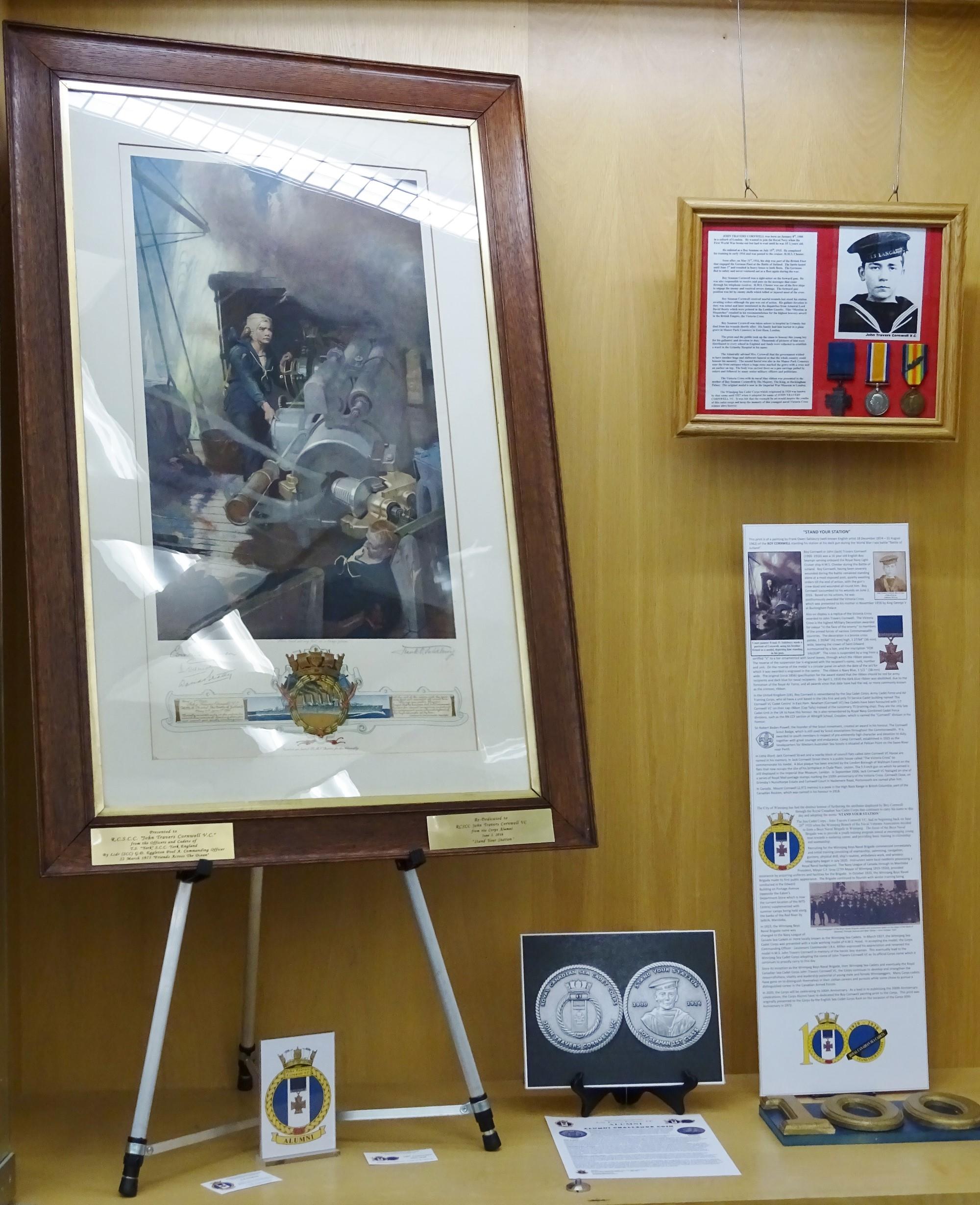 Winnipeg Millenium Library display |
 Manitoba Naval Museum display |
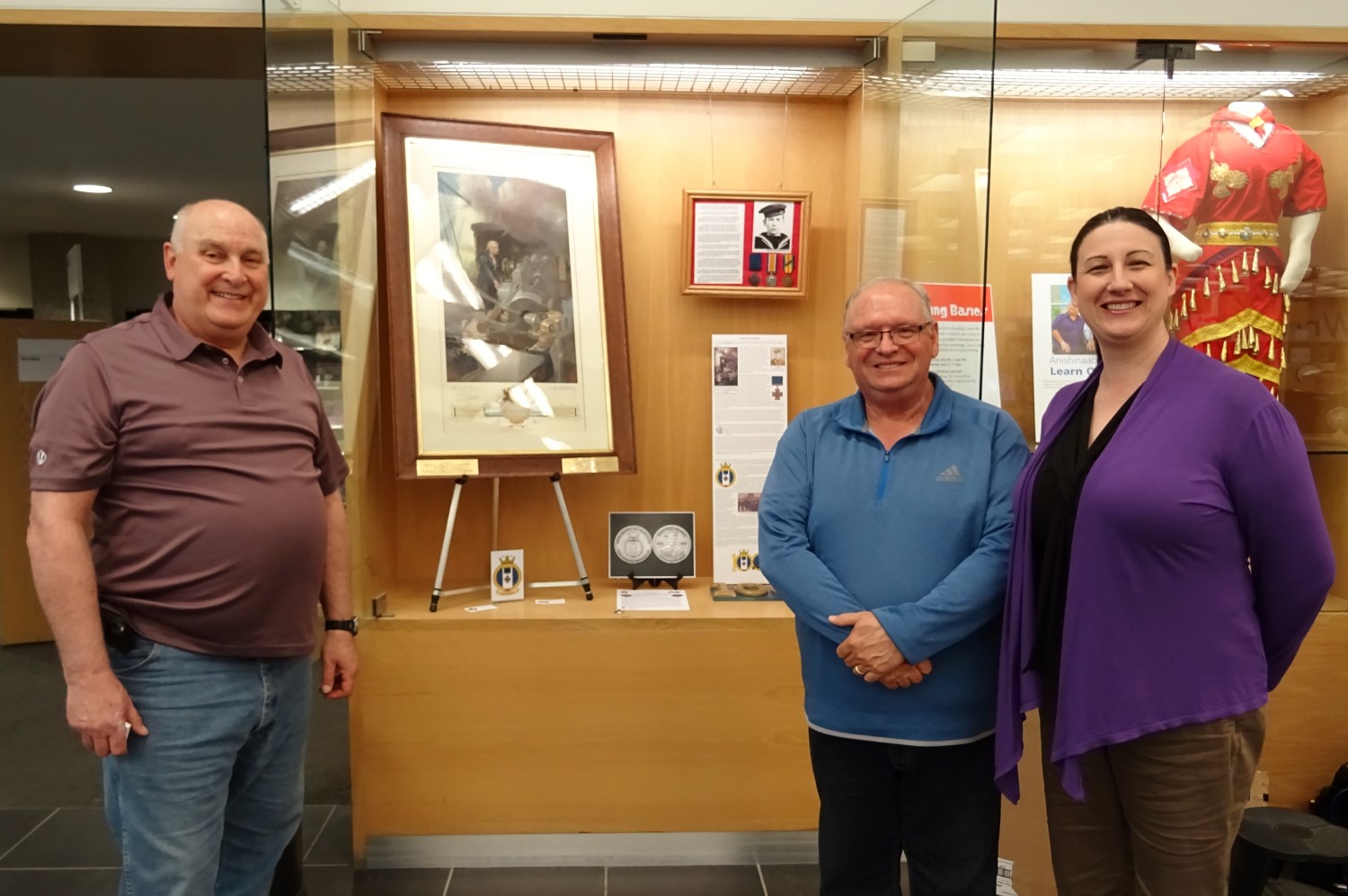 Rick Hunt, John Jamieson and Pam Shaw in front of the Winnipeg Millenium Library display |
|
The following is the text that appears with the display…
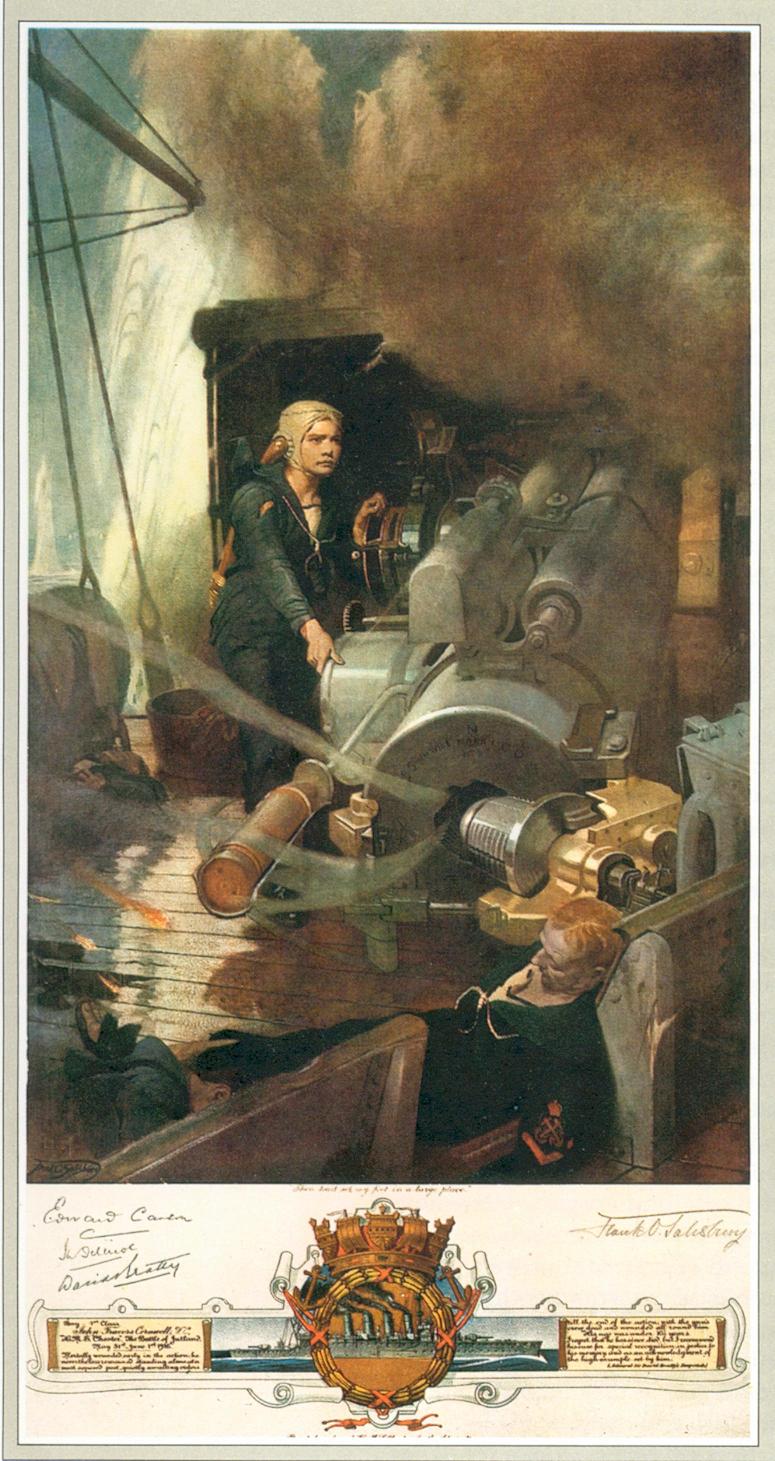 This print is of a painting by Frank Owen Salisbury (well-known English artist 18 December 1874 – 31 August 1962) of the Boy Cornwell standing his station at his deck gun during the First World War sea battle, the Battle of Jutland.
This print is of a painting by Frank Owen Salisbury (well-known English artist 18 December 1874 – 31 August 1962) of the Boy Cornwell standing his station at his deck gun during the First World War sea battle, the Battle of Jutland.
Boy Cornwell or John (Jack) Travers Cornwell (1900 -1916) was a 16 year old English Boy Seaman serving onboard the Royal Navy Light Cruiser ship HMS Chester during the Battle of Jutland. Boy Cornwell, having been severely wounded during the battle remained standing alone at a most exposed post, quietly awaiting orders till the end of action, with the gun’s crew dead and wounded all round him. Boy Cornwell succumbed to his wounds on June 2, 1916. Based on his actions, he was posthumously awarded the Victoria Cross which was presented to his mother in November 1916 by King George V at Buckingham Palace.
Also on display is a replica of the Victoria Cross awarded to John Travers Cornwell. The Victoria Cross is the highest Military Decoration awarded for valour “in the presence of the enemy" to members of the armed forces of various Commonwealth countries. The decoration is a bronze cross pattée, 1 39/64" (41 mm) high, 1 27/64" (36 mm) wide, bearing the crown of Saint Edward surmounted by a lion, and the inscription “FOR VALOUR”. The cross is suspended by a ring from a seriffed "V" to a bar ornamented with laurel leaves, through which the ribbon passes. The reverse of the suspension bar is engraved with the recipient's name, rank, number and unit. On the reverse of the medal is a circular panel on which the date of the act for which it was awarded is engraved in the centre. The ribbon is Navy Blue, 1 1/2 " (38 mm) wide. The original (circa 1856) specification for the award stated that the ribbon should be red for army recipients and dark blue for naval recipients. On April 1, 1918 the dark blue ribbon was abolished, due to the formation of the Royal Air Force, and all awards since that date have had the red, or more commonly known as the crimson, ribbon.
In the United Kingdom (UK), Boy Cornwell is remembered by the Sea Cadet Corps, Army Cadet Force and Air Training Corps, who all have a unit based in the UKs first and only Tri Service Cadet building named 'The Cornwell VC Cadet Centre' in East Ham. Newham (Cornwell VC) Sea Cadets have been honoured with 'J T Cornwell VC' on their cap ribbon (Cap Tally) instead of the customary TS (training ship). They are the only sea cadet unit in the UK to have this honour. He is also remembered by Royal Navy Combined Cadet Force divisions, such as the RN CCF section at Whitgift School, Croydon, which is named the "Cornwell" division in his honour.
 Sir Robert Baden-Powell, the founder of the Scout movement, created an award in his honour, The Cornwell Scout Badge, which is still used by Scout associations throughout the Commonwealth. It is awarded to youth members in respect of pre-eminently high character and devotion to duty, together with great courage and endurance. Camp Cornwell, established in 1925 as the headquarters for Western Australian Sea Scouts is situated at Pelican Point on the Swan River near Perth.
Sir Robert Baden-Powell, the founder of the Scout movement, created an award in his honour, The Cornwell Scout Badge, which is still used by Scout associations throughout the Commonwealth. It is awarded to youth members in respect of pre-eminently high character and devotion to duty, together with great courage and endurance. Camp Cornwell, established in 1925 as the headquarters for Western Australian Sea Scouts is situated at Pelican Point on the Swan River near Perth.
In Little Ilford, Jack Cornwell Street and a nearby block of council flats called John Cornwell VC House are named in his memory. In Jack Cornwell Street there is a public house called "The Victoria Cross" to commemorate his medal. A blue plaque has been erected by the London Borough of Waltham Forest on the flats that now occupy the site of his birthplace in Clyde Place, Leyton. The 5.5-inch gun on which he served is still displayed in the Imperial War Museum, London. In September 2006, Jack Cornwell VC featured on one of a series of Royal Mail postage stamps marking the 150th anniversary of the Victoria Cross. Cornwell Close, on Grimsby's Nunsthorpe Estate and Cornwell Court in Haslemere Road, Portsmouth are named after him.
In Canada, Mount Cornwell (2,972 metres) is a peak in the High Rock Range in British Columbia, part of the Canadian Rockies, which was named in his honour in 1918.
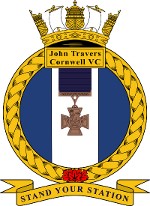 The City of Winnipeg has had the distinct honour of furthering the attributes displayed by Boy Cornwell through the Royal Canadian Sea Cadet Corps that continues to carry his name to this day and adopting the motto “STAND YOUR STATION”.
The City of Winnipeg has had the distinct honour of furthering the attributes displayed by Boy Cornwell through the Royal Canadian Sea Cadet Corps that continues to carry his name to this day and adopting the motto “STAND YOUR STATION”.
The Sea Cadet Corps - John Travers Cornwell VC, had its beginning back on June 20th 1920 when the Winnipeg Branch of the Naval Veterans Association decided to form a Boys Naval Brigade in Winnipeg. The focus of the Boys Naval Brigade was to provide a youth training program aimed at encouraging young men towards a seafaring career, and providing basic training in citizenship and seamanship.
Recruiting for the Winnipeg Boys Naval Brigade commenced immediately and initial training consisting of seamanship, swimming, navigation, gunnery, physical drill, ship’s routine, ambulance work, and wireless telegraphy began in July 1920.
Instructors were local residents possessing a Royal Naval background.
The Navy League of Canada through its Manitoba President, Mayor C.F. Gray (27th Mayor of Winnipeg 1919-1920), provided assistance by acquiring uniforms and facilities for the Brigade. In October 1920, the Winnipeg Boys Naval Brigade made its first public appearance. The Brigade continued to flourish with winter training being conducted in the Edward Building on Portage Avenue (opposite the Eaton’s Department Store which is now the current location of the MTS Centre) supplemented with summer camps being held along the banks of the Red River by Selkirk, Manitoba.
In 1923, the Winnipeg Boys Naval Brigade name was changed to the Navy League of Canada Sea Cadets or more locally known as the Winnipeg Sea Cadets. In March 1927, the Winnipeg Sea Cadet Corps was presented with a scale working model of HMS. Hood. In accepting the model, the Corps Commanding Officer - Lieutenant Commander J.R.K. Millen expressed his appreciation and renamed the model HMS John Travers Cornwell in memory of the heroic boy seaman. This eventually lead to the Winnipeg Sea Cadet Corps adopting the name of John Travers Cornwell VC as its official Corps name which it continues to proudly carry to this day.
Since its inception as the Winnipeg Boys Naval Brigade, then Winnipeg Sea Cadets and eventually the Royal Canadian Sea Cadet Corps John Travers Cornwell VC, the Corps continues to develop and strengthen the resourcefulness, vitality and leadership potential of young male and female Winnipeggers. Many Corps cadets have gone on to distinguish themselves in their civilian careers and pursuits while some chose to pursue a distinguished career in the Canadian Armed Forces.
In 2020, the Corps will be celebrating its 100th Anniversary. As a lead in to publicizing the 100th Anniversary celebrations, the Corps Alumni have re-dedicated the Boy Cornwell painting print to the Corps. This print was originally presented to the Corps by the English Sea Cadet Corps Kent on the occasion of the Corps 50th Anniversary in 1972.
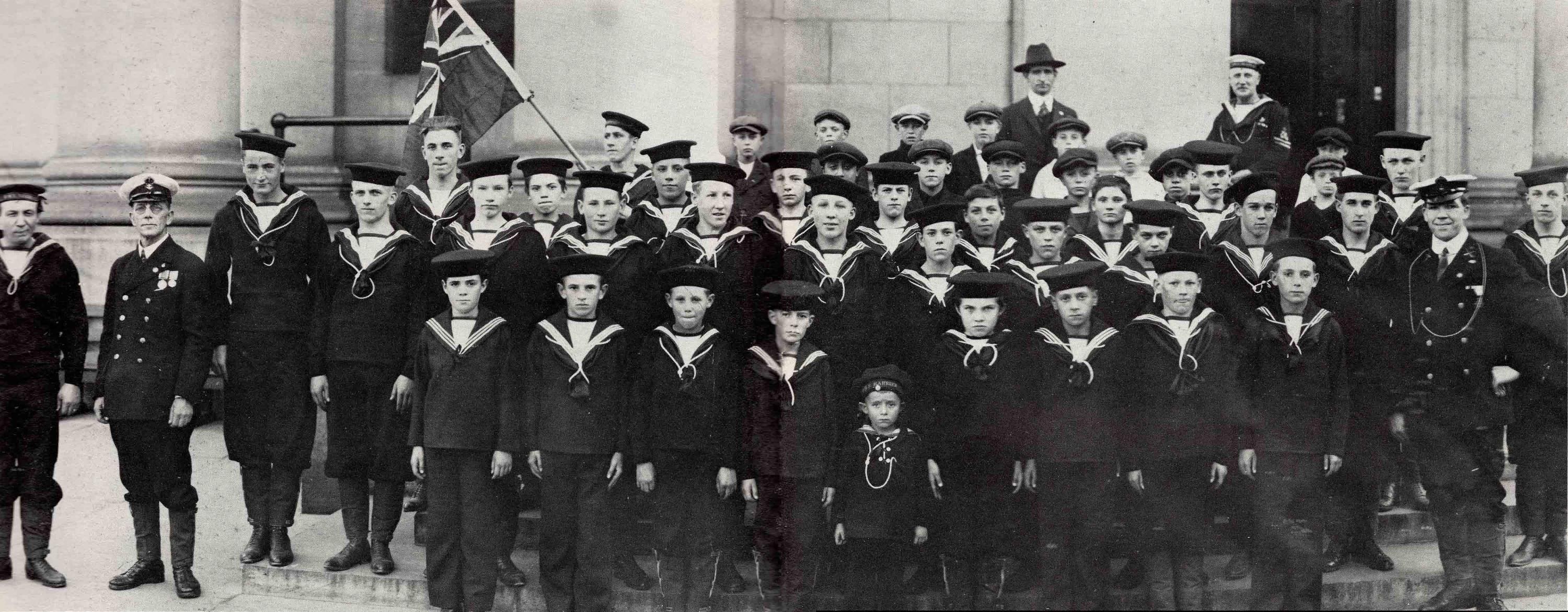
First photograph of Boys Naval Brigade cadets and instructors taken on the steps of the Bank of Montreal, Portage and Main Street, October 1920.